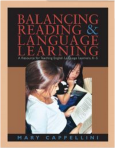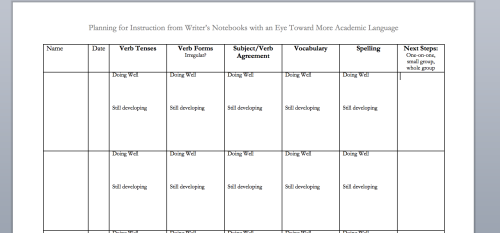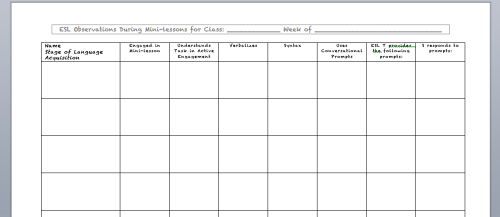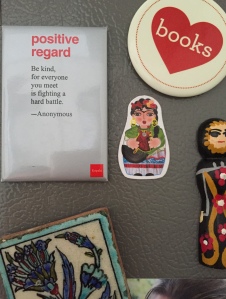Gustavo. This is the time of year I think about him, his round cheeks and bright smile, the high-pitched voice happily proclaiming every morning, “Good morning, Miss DeLiddo, isn’t it a great one?!” as he puttered into the classroom with his tousled brown hair flopping around. A few weeks into the school year, this is the time when I realized just how much Gustavo struggled instructionally and to a lesser extent with language. Up to this point, as I struggled to get to know new students, a new school and a new city, he would begin and end the day sitting in his blue plastic chair swinging his legs as they barely touched the floor, small for a fourth grader, and magically read aloud from the first Harry Potter book. Students would sit around Gustavo captivated. A storyteller you couldn’t help but be drawn to. As I developed a deep affection for this boy’s energy and heart there were gaping holes that I didn’t even know existed.
Know each child’s academic life the deepest that you can.
This is the time of year when Susan, the Special Education teacher, knocked on my heavy wooden door to ask me about scheduling Gustavo’s services. Services?? Gustavo? I was curious. It was my first year in the building and I had not known he was on an IEP nor the specific ESL services he was expected to receive. His beautiful reads, sounding not just good but amazingly lyrical, masked the significant comprehension issues that had him functioning at a first grade level in Reading. He was also designated an English language learner at the Advanced stage of language acquisition, not quite fluent, strong enough to communicate orally and in written form, where at first glance his language deficiencies weren’t evident.
In the craze of the start of the year, I had overlooked so many bits of information that should have been molding my teaching. I wished I had been guided to the information earlier that gave me a better idea of each learner. There is so much data collected and filed but in many cases it is neglected. Making the time to look closely at it and fully understand the implications for future instruction takes purpose. Communities must make time to encourage teachers and service providers to talk deeply about the children in our midst.
Thinking about Gustavo at the start of the school year reminds me of the necessity of knowing. Knowing all that you can. Understanding all that is presented. Too often the pace of the year doesn’t allow educators to fully understand the assessments we give though the teaching options are myriad. Data. In their book Between Worlds: Access to Second Language Acquisition (Heinemann, 1994), David and Yvonne Freeman wrote, “It is not surprising that social language generally develops first; it serves students’ immediate needs… Unfortunately, in many classrooms academic language develops slowly because the curriculum is future oriented. Students are told to study a subject because ‘someday you are going to need to know what is being taught today.'” We need to know what the language is that students have and the language they need to strengthen. Basing our teaching on knowledge they can transfer immediately is important. Balancing the academic language (which is different for individual students) along with meaningful learning is something to plan for within and across units of study. Running records and written samples such as notebooks, booklets and on-demand pieces provide us with so much rich information about language and literacy. Knowing what to look for is crucial!
Many teachers support ELLs in beautiful ways without the background in language acquisition and a couple of additional resources would help to focus on language. One all-time favorite of mine, and thousands of other educators, is (friends/colleagues of mine will now laugh and chime in)… p. 29 from Mary Cappellini’s book Balancing Reading and Language Learning (Stenhouse, 2005). http://www.stenhouse.com/html/balancing-reading-and-language-learning.htm The book transforms. This page transforms. Based on California’s former ELD standards (they were revised at the end of 2012) this one page should be in every teacher’s conferring toolkit when thinking about English language learners. It helps us to put words and next steps on language teaching by laying out the developmental levels as well as common language patterns expected at each.
CA English Language Development Standards are posted at: http://www.cde.ca.gov/sp/el/er/eldstandards.asp
Another similar resource teachers have found quite helpful in providing specific guidance to language instruction is Susana Dutro’s ELD Matrix of Grammatical Forms accessible on E.L. Achieve’s website: http://www.elachieve.org/eld-matrix-of-grammatical-forms-posters.html
A guide sheet I have used with teachers when analyzing running records alongside Mary’s p. 29:
When looking closely at writing samples, I tend to use this form to record specifics:
At PS 199 in Long Island City, the ESL teachers (implementing the push-in model) and I thought about the specific aspects of language and behavior they wanted to take note of during minilessons delivered by the classroom teachers. This allowed the ESL teachers to be actively engaged in the classroom while providing support. We created an observation form that teachers could individualize for groups of students they were servicing. It’s a wonderful way to collect formative data to plan for upcoming sessions with learners and is a ‘choose your own adventure’ type of record keeping system. Decide what you want to know more about and research it!
Gustavo. This is the time of the year when I got to know his mamá, tiny and polite, perfectly coiffed shoulder-length hair and always smiling sweetly, a bit overprotective of her only child. How his eyes sparkled when she came to pick him up each day. I noticed how excited he was to talk about his dad and the yummy pizza he delivered for the restaurant down the road. This is the time of year when I found out that his father, the pizza delivery man in the rusty car, had been a practicing attorney in Mexico. Gustavo’s mom was a nurse. And the story. One weekend when Gustavo was about two years old, both of his parents were tied up for an extended period of time and the family was robbed at gunpoint inside their home. The young son was toddling around the house the entire time and was witness to the violence. The details took my breath away. After a few days, the assailants left and the family fled with what little they could carry. With the help of friends and strangers they settled in Central Massachusetts and began to build a new life.
Know each child’s life the deepest that you can.
Many researchers in the world of language acquisition (Jim Cummins, Yvonne and David Freeman, Steve Krashen, etc) discuss at length the importance of knowing as much as possible about the individual students’ backgrounds. It is life-changing for the student and the teacher when understandings appear! Knowing and attempting to understand these details gave me a chance to carry them into my teaching and my communication. The power of knowing more transforms the educational experiences.
Colorín Colorado is a magnificent website that educators of language learners should know and visit. They have a post that I have used in conversation to breakdown the specifics that we should know and wonder about our students. http://www.colorincolorado.org/educators/reachingout/backgrounds/ .
In addition to culture and language, some questions to find out home life may include:
- Who lives at home? Parents, grandparents, aunts, uncles, older siblings? How many of them speak English? How many know how to read in English and/or Spanish?
- How long have they been in the United States? Why did they come?
- How familiar are they with the U.S. school system?
- What is the child’s prior educational experience?
- Has the child been formally instructed in English before? If so, for how long?
- Do they come from a big city or a rural town?
- Does your student have a quiet place to study? Is there someone to help with homework?
(from Colorín Colorado, 2007)
This is the time we begin to find the rhythm of the school year. Routines are solidified and relationships form. A month into the school year is when we begin to better understand the personalities and backgrounds of our students and our colleagues. This year feels particularly challenging for me as it is the first in twelve I haven’t been scheduling my work in schools for the Teachers College Reading and Writing Project. Change is hard. Change is sad even when we know the change is for the best. Change is exciting and empowering.
At eye level on my refrigerator is a magnet from Kripalu surrounded by a piece of tile from Syria and a wooden doll from Jordan. “Be kind, for everyone you meet is fighting a hard battle.” Each of those places holds an unbelievably powerful place in my heart and each is brimming with people fighting battles we may never know or understand. We must try. This is a mantra I wish for all of us to carry into our work with each and every child who crosses our path. I hope for all the learners in our classrooms that we pause at this time of year to consider kindness. Take the time. It can change someone’s life. Knowing and understanding.
besos,
Emily







Beautifully written. Thoughtful and enlightening.
Thank you, Emily.
LikeLiked by 1 person
Every student needs a teacher that can sit with them in hard battles.
LikeLiked by 1 person